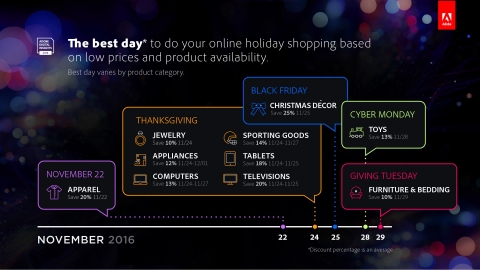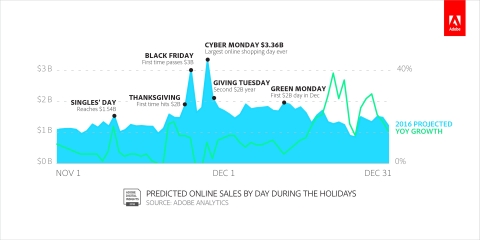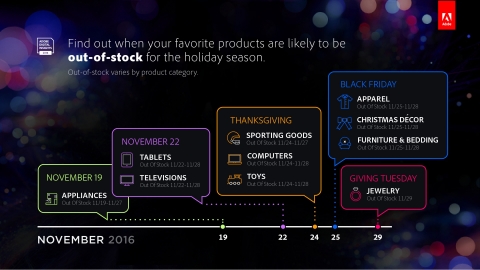SAN JOSE, Calif.--(BUSINESS WIRE)--Adobe (Nasdaq:ADBE) today released its 2016 Digital Insights Shopping Predictions for the upcoming holiday season. The breadth of data Adobe analyzes has allowed the company to successfully predict consumer spending within two percent in previous years, the most accurate in the industry. Adobe expects an extended holiday season with consumers shopping much earlier and later in the season. For the first time, 53 consecutive days (57 calendar days in total) will exceed $1 billion in online sales, versus 31 consecutive days last year, a 71 percent year-over-year (YoY) increase. Cyber Monday is expected to be the largest online shopping day of all time, generating $3.36 billion in sales with 9.4 percent growth. Sales on Thanksgiving Day will increase 15.6 percent YoY to $2 billion, but not reach the 25 percent YoY increase of 2015. Black Friday will grow 11.3 percent YoY (14.3 percent in 2015) to $3.05 billion.
The extended season will lead to an eleven percent ($9.1 billion) increase in online sales to a total of $91.6 billion. Large retailers* are expected to account for the bulk of the growth, with an average growth rate of 16.6 percent compared to smaller retailers at seven percent. For the average retailer, five percent of consumers are expected to drive 35 percent ($38.5 billion) of all online sales while one percent of product SKUs will account for 74 percent of sales. For the first time mobile devices will exceed desktops in shopping visits, 53 versus 47 percent respectively. However, mobile shopping visits will only account for 34 percent of sales, a 19 percent gap between visits and purchases (see separate press release), likely a consequence of poor mobile shopping experiences. In addition, Adobe data shows that total organic web traffic in North America is stalling with only 0.1 percent growth over the past 42 months (see separate press release).
“We expect to see a five percent spike in online shopping in early November and a record 24 percent increase in the last two weeks of December,” said Mickey Mericle, vice president, Marketing and Customer Insights at Adobe. “‘Click and collect,’ faster shipping and retail promotions starting earlier than ever are all contributing to the extended shopping season. Despite the uptick in sales we expect to see slower growth in total online sales this year.”
Top Gifts
Consumers who price shop will be able to save an average of 20 percent by shopping for the same products across online retailers. The most desired gift items this season are expected to be VR devices (Oculus, PlayStation VR and HTC Vive), Pokémon, Barbie, Lego, Hot Wheels and Frozen toys, as well as Google Home and Amazon Echo. According to a complementary Adobe survey, consumers will spend 15 percent of their money on gifts for themselves compared to 66 percent on gifts for others and 19 percent for decorations and parties. Lower prices and free shipping remain the primary reasons people shop online, although convenience is on the rise.
Additional findings include:
- The best dates for deals and highest out-of-stock days vary by product category. For example, discounts for apparel will be highest on Tuesday before Thanksgiving Day while game consoles will see highest out-of-stock notifications on Thanksgiving Day and Black Friday. (See graphic for more details.) Despite the ability to find steep discounts, 25 percent of customers will end up paying higher prices because they are loyal to a retailer. Forty-one percent of products will be purchased at the retailer with the lowest price during the holiday season versus 31 percent during the rest of the year.
- Mobile shopping: Despite slower growth in mobile visits, Thanksgiving Day and Christmas will be the biggest mobile retail days of the year (59 percent and 66 percent respectively). Cyber Monday will see 49 percent in mobile visits with the largest increase (ten percent).
- Online sales growth by state: Washington, D.C., Washington, Nevada, Kansas and Nebraska will see the highest growth in online sales (from 15 to 36 percent). Delaware, Kentucky, Arkansas, West Virginia and Mississippi will see the lowest growth (from four to five percent). The highest growth states typically have populations with more graduate degrees, more student debt, more total debt and higher rent as share of income.
- Finding the best deals: Consumers are most likely to find the best deals through display advertising (29 percent), followed by social media (14 percent) and email (13 percent). Forty percent of consumers indicate email is the best way to reach them on a mobile device while they are shopping for the holidays.
Adobe leverages machine learning to identify retail insights from the billions of data points that flow through Adobe Marketing Cloud. The resulting predictive model is the most comprehensive and accurate one in the industry. The forecast is based on an analysis of 55 million product SKUs and aggregated and anonymous data of more than one trillion visits to 4,500 retail websites. Seven dollars and fifty cents out of every ten dollars spent online with the top 500 U.S. retailers go through Adobe Marketing Cloud.* Adobe is able to track 80 percent of all transactions from the top 100 retailers in the U.S.**
Helpful Links:
- Adobe Digital Insights 2016 Online Shopping Prediction (Full Report): http://www.slideshare.net/adobe/2016-holiday-shopping-predictions
- CMO.com Article: http://www.cmo.com/adobe-digital-insights/articles/2016/10/19/adi-holiday-predictions-report-2016.html
- Digital Marketing Blog Post: http://blogs.adobe.com/digitalmarketing/adobe-digital-insights/adobe-digital-insights-adis-2016-holiday-shopping-predictions/
- Infographic: http://www.slideshare.net/adobe/infographic-2016-holiday-predictions
About Adobe
Adobe is changing the world through digital experiences. For more information, visit www.adobe.com.
* Based on the top 100 retailers in the IR 2016 Top 500 eGuide
** Internet Retailer’s 2016 Top 500 eGuide, an independent source that measures online commerce technologies
© 2016 Adobe Systems Incorporated. All rights reserved. Adobe and the Adobe logo are either registered trademarks or trademarks of Adobe Systems Incorporated in the United States and/or other countries. All other trademarks are the property of their respective owners.






